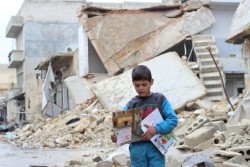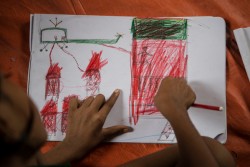

【2017年12月28日 ニューヨーク発】
ユニセフ(国連児童基金)はこの1年を通し、世界の紛争地域では、紛争当事者が最も弱い立場にある人々を保護することを目的とした国際法をあからさまに無視し、そこに暮らす子どもたちが驚くほどの規模の攻撃を受けた、と警鐘を鳴らしました。
 |
|
© UNICEF/UN055818/Al-Issa |
|
ユニセフが配布した地雷教育用のマニュアルを手にする子ども。(シリア)2017年1月撮影 |
「子どもたちは家で、学校で、そして公園で、攻撃の対象にされ、攻撃や残虐な暴力に晒されています」とユニセフ本部緊急支援局長のマヌエル・フォンテーヌは 述べました。「このような攻撃が何年も続いていても、私たちはそのことに対して反応を鈍らせてはいけません。このような残虐行為を新たな日常にしてはならないのです」
世界中で起きている紛争では、子どもたちは前線の攻撃対象とされ、人間の盾として使われ、殺害され、生涯残る傷を負わされ、戦闘に徴兵・徴用されます。強姦、強制的な結婚、拉致、奴隷化することが、イラク、シリア、イエメンからナイジェリア、南スーダン、ミャンマーまで、各地の紛争で広く一般的な戦術となっています。
いくつかの地域では、過激グループに拉致された子どもたちが、解放され治安部隊に拘留された際に再度虐待を受けることがあります。さらに何百万人もの子どもたちが、これらの紛争の代償を間接的に払わされています。戦闘により食糧、水、衛生や保健などの社会サービスが奪われ、ダメージを受け、破壊され、子どもたちは栄養不良、病気、そしてトラウマに苦しんでいます。
■2017年のデータ:
 |
|
© UNICEF/UN0143092/LeMoyne |
|
ロヒンギャ難民の子どもが描く絵。(バングラデシュ)2017年10月29日撮影 |
ユニセフは、すべての紛争当事者に対して、国際法が定める責任を果たし、直ちに子どもに対する暴力と学校や病院などの市民の生活に不可欠な施設やインフラへの攻撃を終わらせるよう求めます。ユニセフは、紛争当事者に影響力を持つ各国政府に対しても、その力を子どもの保護のために使うよう求めます。
これらのすべての国々で、ユニセフはパートナー団体と協力し、最も弱い立場にある子どもたちに対して、保健、栄養、教育および子どもの保護サービスの分野での支援を提供しています。
【関連ページ】
シェアする